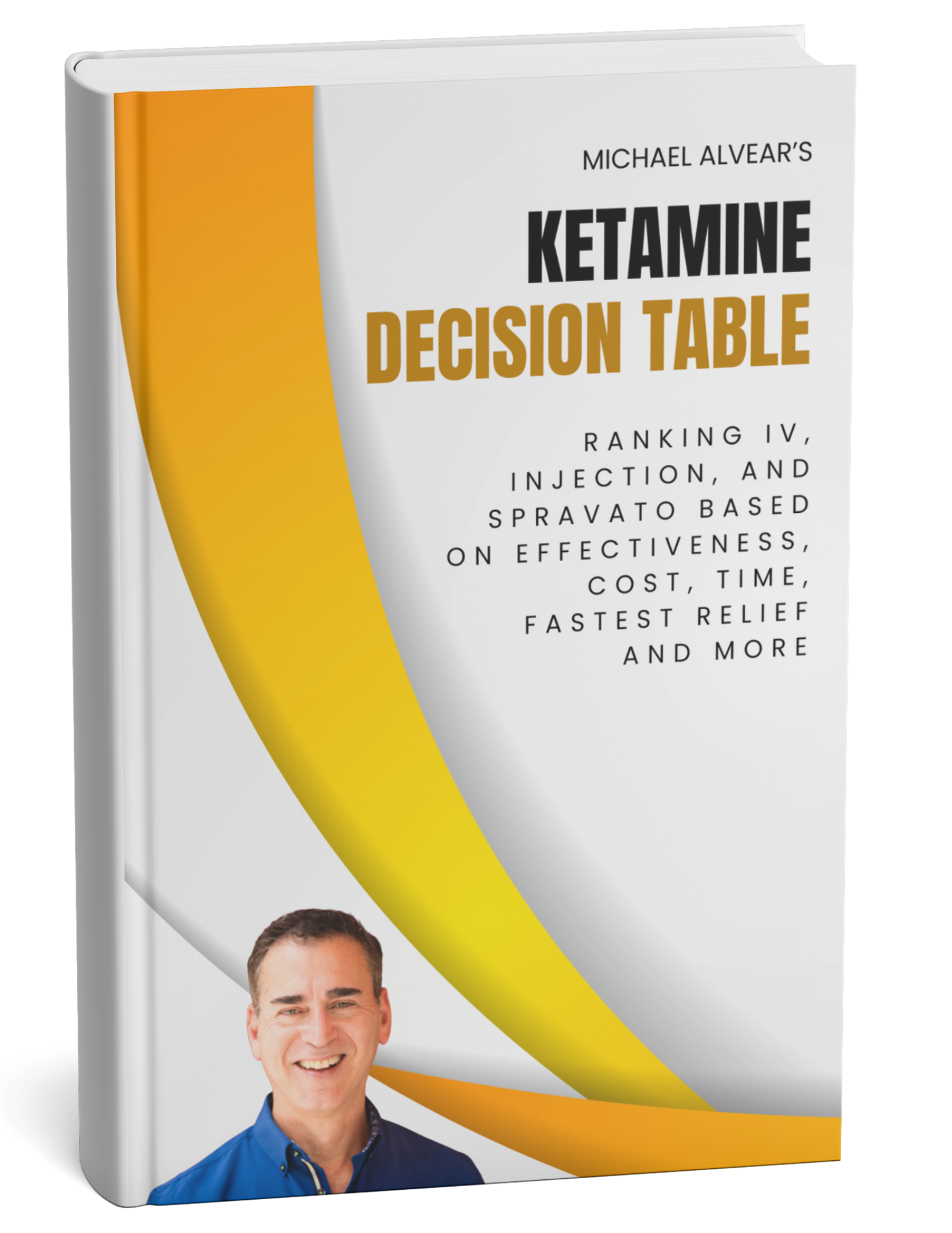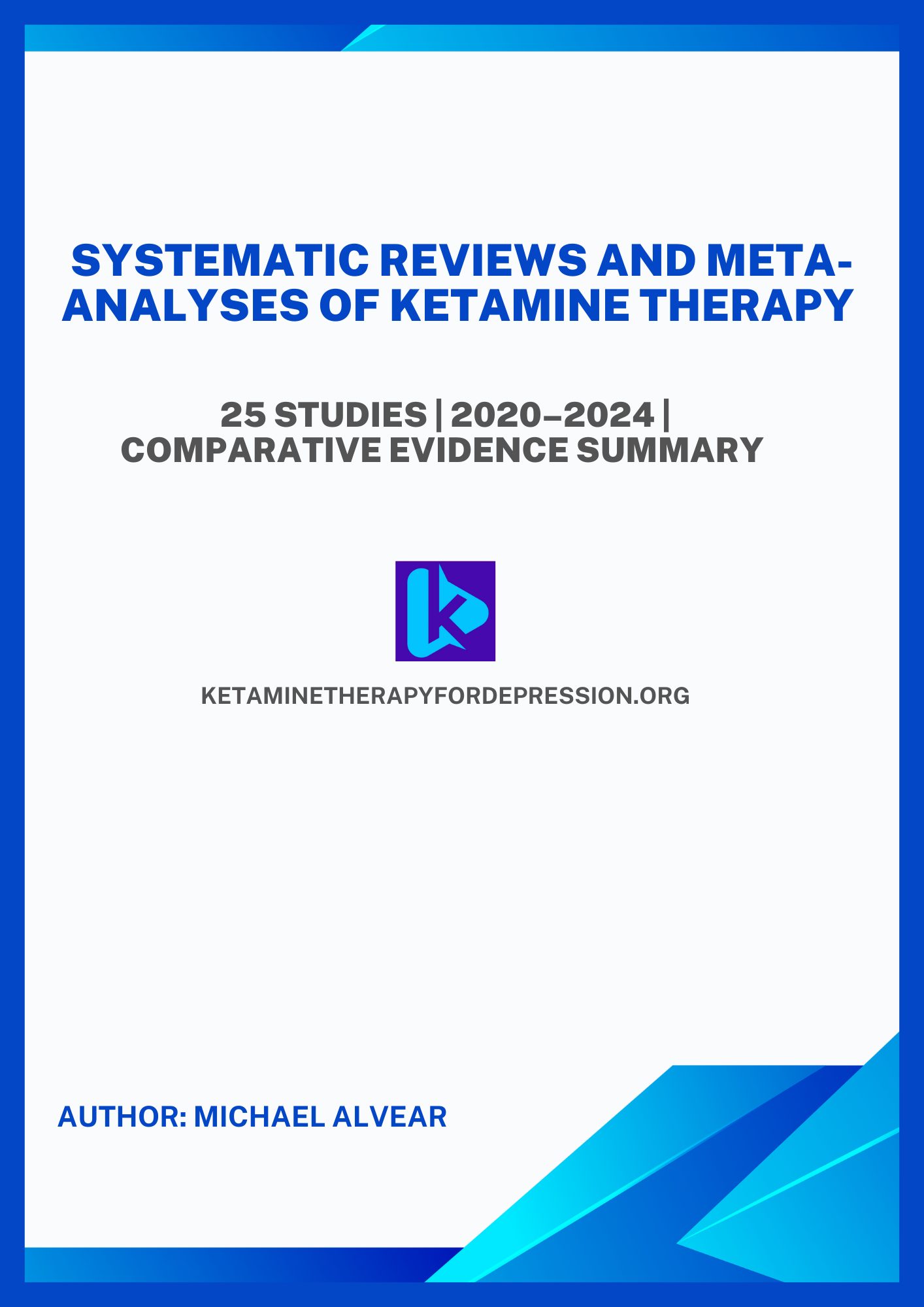How Many IV Ketamine Infusions You’ll Need For Depression
By Michael Alvear, Health Author & Independent Researcher
My research is published on these scholarly platforms:
Last Updated:
How Many IV Ketamine Treatments You’ll Need
For depression, IV ketamine is typically given as 11–18 infusions over six months:
Phase 1: 6–8 infusions in the first month
Phase 2: weekly infusions in month two
Phase 3: maintenance infusions every 2–4 weeks
Unlike the FDA-approved nasal spray Spravato, which follows a rigid 21-dose schedule, IV ketamine has no standardized protocol. That flexibility allows providers to personalize your treatment, but it also makes it harder to predict what your care will look like week to week or month to month.
This guide breaks down real-world treatment patterns into three phases: the first six months (Wave 1), the optional maintenance period from months 7 to 12 (Wave 2), and long-term or PRN (as needed) treatment for year two and beyond (Wave 3). We’ll walk you through how frequency typically changes over time, what kinds of patients continue past six months, and what you can realistically expect if ketamine works for you—or if it doesn’t.
Considering nasal spray options instead? Check out how many Spravato sessions you’ll need for depression treatment—the schedule and administration are quite different from IV infusions.
How Many IV Ketamine Treatment Sessions Will I Need?
| WAVE 1 Treatment Phase (6 months) | WAVE 1 Month | WAVE 1 Weeks / # of sessions (IV/injection ketamine) | WAVE 1 Total Monthly Sessions (IV/injection ketamine) |
|---|---|---|---|
| Induction Phase | Month 1 | 2–3x per week (6–8 total) | 6–8 |
| Early Maintenance Phase | Month 2 | 1x per week (avg) | ~4 |
| Continued Maintenance | Months 3–6 | 1x every 2–4 weeks (avg) | ~4–6 |
| Total # of sessions in Wave 1 (6 months) | 11–13 (low end) 14–18 (high end) |
||
NOTE: The vast majority of patients do not continue IV ketamine infusions beyond six months—either because they’ve reached remission, the treatment didn’t help, or their provider determines that boosters are no longer necessary. While some patients continue with low-frequency maintenance, most treatment plans taper off or end entirely within the first half-year.
★
Takeaway
Most patients receive 11 to 18 IV or injection ketamine sessions in the first six months, then stop treatment entirely—either because they reach remission, don’t respond, or no longer need boosters.
Note: The induction phase requires six to eight infusions within four weeks, typically two to three clinic visits per week. Because you cannot drive for several hours after each session due to dissociation and cognitive effects, you’ll need to arrange reliable transportation for every appointment. If coordinating rides with family or friends at that frequency feels unsustainable, reviewing our guide
Steps to Arrange Medical Transportation for Appointments
before starting treatment prevents gaps in your protocol when consistency matters most.
Can’t Decide Between IV, Injections, Or Spravato?
Use My Decision Table

This report ranks all three options—IV, injection, and Spravato—on effectiveness, cost, fastest relief, and more, giving you a clear framework to decide.
Downloads as PDF • 5 minute read
Why Does IV Ketamine Treatment Frequency Vary From Patient To Patient?
When you’re trying to climb out of treatment-resistant depression, you don’t just need hope—you need a roadmap.
With Spravato, the FDA-approved nasal spray, you get one. The schedule is rigid and defined: 21 sessions over six months.
With IV ketamine, the number isn’t fixed. You’ll often hear a range like 11–18 sessions. That may sound vague—or even suspicious. Why doesn’t IV ketamine come with a specific plan? Why is one treatment so locked down, while the other seems to float?
This guide unpacks those questions so you can make a decision based on what’s actually known—not what’s assumed.
Unlike Spravato’s fixed 21-session calendar, IV ketamine adjusts frequency based on your progress—you might taper to biweekly visits or maintain weekly sessions longer. This flexibility is clinically beneficial but complicates transportation planning for Non-Emergency Medical Transportation (NEMT) rides requiring advance scheduling. Learning what NEMT covers and how to schedule helps you adapt arrangements as your provider personalizes the protocol.
How Does Spravato’s Fixed 21-Dose Schedule Compare To IV Ketamine’s Flexible Approach?
Spravato’s dosing schedule was built into its FDA approval. The trials followed a strict timeline:
- Twice weekly for 4 weeks (8 doses)
- Once weekly for 4 weeks (4 doses)
- Then once every 2 weeks for maintenance (9 doses over 4 months)
That’s 21 sessions in six months. Not because every patient needs that many—but because that’s what the FDA signed off on. And insurance companies won’t reimburse unless providers follow it. The number is clear because it’s required, not because it’s optimal.
Why Does IV Ketamine Offer More Personalized Treatment Than FDA-Approved Spravato?
IV ketamine isn’t FDA-approved for depression. So instead of one locked-in protocol, you get clinical judgment, pattern recognition, and responsiveness to your individual symptoms. See why IV ketamine is considered superior to Spravato even though it doesn’t have FDA approval.
There’s broad agreement on the starting point: 6 to 8 infusions over 2 to 4 weeks, known as the induction phase. After that, everything depends on how you respond. Some patients taper quickly. Others need more time. There’s no single next step—because there’s no single pattern of healing.
IV ketamine is less like a prescription with fixed refills and more like a dimmer switch. You raise or lower the frequency depending on how much light you need.
What Factors Determine How Many IV Ketamine Infusions You’ll Need?
We split the estimate into two ranges that reflect real-world use.
Low-End Range: 11–13 Sessions Over Six Months
This applies to patients who respond well to induction and stabilize quickly. They taper to once-monthly maintenance or even stop entirely. These patients typically complete:
- 6–8 sessions in Month 1
- 1 booster per month for the next few months
It’s not common—but it’s not rare either. This path reflects ASKP3’s guidance and some academic protocols.
High-End Range: 14–18 Sessions Over Six Months
This reflects patients who need more support to stay in remission. They may get:
- 6–8 infusions in Month 1
- Weekly or biweekly boosters for 1–2 months
- Then monthly sessions for the remainder
One large real-world study found that patients didn’t reach monthly spacing until Month 4 or later. That pushes the total toward 14–18 sessions, even with good outcomes.
How Do Ketamine Clinics Decide When To Continue Or Stop Your Treatment?
A fair concern many people have is: if this isn’t regulated, how do I know I won’t be strung along forever?
Most IV ketamine clinics reassess progress every few weeks. If you haven’t responded by infusion 4 or 5, many providers recommend stopping or exploring other treatments. You won’t be kept in a holding pattern with no end. The best clinics build in review points—because they don’t want to waste your time or money either.
Is IV Ketamine’s Flexible Treatment Schedule A Benefit Or Concern For Patients?
Not at all. Spravato gives you a number because it has to.
IV ketamine gives you a range because it adapts to your biology.
This is not guesswork—it’s flexibility. And for some people, that’s the difference between staying well and staying stuck.
How To Determine If IV Ketamine’s Personalized Approach Is Better For Your Depression Treatment
If you need predictability and insurance coverage, IV ketamine may not be ideal.
But if you want a treatment that responds to how you feel—and doesn’t keep you locked into a fixed schedule—it may give you more value, not less.
Typical IV Ketamine Treatment Plan at a Glance
- FDA approved: No
- Total sessions over 6 months: 11–18
- Remission odds: 2–5x higher than Spravato in early studies
- Insurance coverage: Rare (usually self-pay)
- Visit burden: Fewer sessions, shorter appointments
- Flexibility: High. Adjusts based on response
Why Doesn’t IV Ketamine Follow A Standard Treatment Protocol Like Spravato?
We estimate 11 to 18 sessions over six months not because the science is uncertain, but because your symptoms don’t follow a grid.
IV ketamine doesn’t prescribe a fixed path. It lets you build one.
That’s not vague. That’s how recovery works.
Takeaway
IV ketamine has no fixed session count because it isn’t FDA-regulated—unlike Spravato’s 21-dose protocol, treatment is adjusted case by case based on how each patient responds.
Frequently Asked Questions About How Many IV Ketamine Sessions You’ll Need
Straight answers about IV ketamine treatment schedules, outcomes, and decision points—based on how it actually works.
How many IV ketamine therapy sessions do most people need—and what affects the total number?
Most patients receive between 11–18 ketamine infusions over six months, with the majority frontloaded in the first 4–12 weeks. The treatment follows a clear pattern: 6–8 intensive sessions during month one (induction phase), weekly sessions in month two, then gradual spacing to every 2–4 weeks during months three through six.
When paired with psychotherapy, IV ketamine achieves up to 72% remission rates, with most successful patients reaching remission within the first three months due to ketamine’s rapid-acting properties. Your personal treatment count depends primarily on response speed, depression severity, and how well your improvements last between sessions.
What’s the typical IV ketamine treatment schedule for depression—and how does it change over time?
The standard ketamine protocol begins with 6–8 infusions administered 2–3 times weekly during the first month (induction phase). In month 2, treatments typically reduce to once weekly. Months 3–6 see further tapering to once every 2–4 weeks. Six-month total number of infusions: 11–18.
If treatment continues beyond six months—something most patients don’t need because they’ve either reached remission, found enough relief, or decided it isn’t helping—sessions decrease to once every 3–5 weeks in months 7–8, then to monthly or less frequent by months 9–12.
By year two, the few patients still receiving treatment typically need only quarterly infusions. This gradual reduction reflects how ketamine’s effects often become more sustained over time, allowing longer intervals between maintenance doses while preserving symptom relief.
What happens if IV ketamine doesn’t work after the first few infusions—and when do clinics usually recommend stopping?
IV ketamine works fast—and if it’s going to help, you’ll usually see a clear response within the first 2 to 4 infusions. That’s why most clinics build a reassessment point early in treatment. If you haven’t improved by 50% or more, providers typically recommend stopping or switching approaches.
Some may adjust dose or timing, but few continue beyond infusion #4 without significant signs of progress. In studies combining IV ketamine with psychotherapy, up to 72% of patients reach remission—often within the first three months. That’s why experienced clinics build in early decision points: to make sure you’re on the right track, and to avoid wasting your time, money, or hope on a treatment that isn’t delivering.
When do most people stop getting ketamine IV infusions—and what determines if someone needs to continue?
Most people reach a turning point by the third or fourth infusion. That’s when clinics reassess: Is ketamine helping—and is it worth continuing? Because IV ketamine works fast, providers expect to see at least a 50% improvement early on.
If you’re showing progress, treatment usually continues—often with the same frequency, or with small changes to dosage or spacing to maximize results. Many clinics fine-tune the protocol in these first weeks to strengthen the response. And if things keep improving, they stay the course.
But even among responders, most providers set another decision point around the end of Month 3. That’s because IV ketamine delivers its strongest results early. Our analyses show that when ketamine is paired with psychotherapy, up to 72% of patients reach remission within that window. So if you haven’t hit major milestones by then, most clinics will recommend stopping treatment and look for alternatives, rather than stretching treatment into a slow fade with no clear benefit.
What IV Ketamine Maintenance Looks Like After the First 6 Months
While some patients continue into a second phase of IV ketamine treatment after the first six months, most do not. The vast majority either reach remission, stop due to lack of benefit, or no longer need regular booster infusions. For those who do continue, Wave 2 typically involves less frequent sessions—often spaced out to every few weeks or longer. The table below reflects common maintenance patterns during Months 7 to 12, based on real-world clinic behavior and observational studies.
IV Ketamine Treatment Frequency Month 7-12 (Wave 2)
| WAVE 2 Treatment Phase (6 months) | WAVE 2 Month | WAVE 2 Weeks / # of sessions (IV/injection ketamine) | WAVE 2 Total Monthly Sessions (IV/injection ketamine) |
|---|---|---|---|
| Ongoing Maintenance | Month 7 | 1x every 3–5 weeks (avg) | ~1 |
| Ongoing Maintenance | Month 8 | 1x every 4–5 weeks (avg) | ~1 |
| Tapered Maintenance / As Needed | Months 9–12 | 1x monthly or fewer (avg) | ~1–2 total |
| Total # of sessions in Wave 2 (Months 7–12) | ~3–5 | ||
Takeaway
Most patients stop IV ketamine after six months because its fast-acting effects either lead to remission, bring them close enough that they’re satisfied with the results, or make it clear early on that it isn’t working.
Research Notes & Citations on IV Ketamine Treatment Protocols
The following collapsible sections contain detailed research notes and clinical evidence on IV ketamine treatment protocols for treatment-resistant depression. Click on each section to expand and read the detailed information.
Wave 1 (Months 1–6) – Induction and Early Maintenance
Induction Phase (Weeks 1–4): Most protocols begin with a short induction series of 6–8 IV ketamine infusions over 2–4 weeks, typically 2–3 infusions per week. For example, a common regimen is 0.5 mg/kg infused over about 40 minutes, given twice weekly for 3–4 weeks. This induction aims to rapidly reduce depressive symptoms. Clinical policies advise reassessing after the induction series to decide on continuation. Initial response rates around 50–70% have been reported with such induction protocols in real-world settings.
Early Maintenance (Months 2–6): For patients who respond to induction, practice guidelines suggest transitioning to a maintenance schedule with less frequent infusions, tailored to the duration of ketamine’s effects. In the first few months post-induction, many clinics schedule booster infusions roughly every 1 to 4 weeks as needed to sustain remission. For example, one academic program notes that after the initial 6–8 doses, the antidepressant effect of each ketamine infusion tends to last about 3 weeks, guiding an average maintenance interval of one infusion every 3 weeks during this phase. Similarly, the American Society of Ketamine Physicians (ASKP3) reports that most patients require maintenance treatments and these are often administered approximately once a month on average (with a typical range from every 2 weeks up to every 3 months) depending on individual response. Notably, some patients can maintain their improvement for several weeks without any infusion – one large analysis found about 80% of responders still had benefit at 4 weeks post-induction without additional ketamine, though by 8 weeks this fell to ~60%. Thus, during months 1–6, many providers start with fairly frequent boosters (e.g. weekly or biweekly) immediately after induction and then gradually extend the interval (to monthly or longer) if the patient’s remission holds. There is no single universal schedule; instead, infusion frequency in this early maintenance period is adjusted based on how quickly depressive symptoms begin to return in each patient.
Wave 2 (Months 7–12) – Continued Maintenance (Late Year 1)
Maintenance Approach: Beyond six months, formal data are limited, but available evidence suggests that many patients do not require very frequent infusions by this stage, and some may discontinue treatment. In a large real-world study of >1,000 TRD patients, those who continued ketamine after induction received a median of about one infusion every 28 days during maintenance. This implies a roughly monthly booster schedule is common in practice for ongoing responders. Crucially, this same analysis found that the median patient exited treatment by around 6 months, meaning relatively few continued frequent infusions into months 7–12. Among the subset who did continue, there was no pattern of needing progressively shorter intervals (i.e. no dose escalation or tolerance requiring increasing frequency) – maintenance infusion spacing generally remained stable or even lengthened over time. Clinical reports indicate that if remission is sustained, providers often try to space out infusions to the longest interval that still prevents relapse, which in late year 1 is often monthly or even less frequent.
Outcomes up to 12 Months: While controlled trials beyond 6 months are lacking, some observational studies suggest that those who stay on maintenance ketamine can maintain their improvements through 12 months. For example, one multi-center chart review noted that depressive symptoms remained largely stable up to one year in patients continuing periodic ketamine, with minimal increases in depression scores during the maintenance phase. However, this finding comes from non-randomized data and likely reflects a self-selected group of responders. By the end of year 1, roughly 30–50% of initial responders may still be receiving occasional maintenance infusions, whereas others have either tapered off (if in remission) or stopped due to relapse or other reasons. In summary, months 7–12 usually involve ongoing but infrequent boosters (about one per month or less) for the minority of patients who continue, and careful monitoring to determine if continuing treatment is warranted on an individual basis.
Wave 3 (Year 2 and Beyond) – Long-Term Use (Maintenance or Discontinuation)
Limited Data for Year 2+: There is a paucity of published guidance beyond 12 months of IV ketamine therapy. No randomized trials have examined maintenance into a second year or longer. What is known comes from case series, clinic protocols, and expert opinion. These suggest that some patients do continue ketamine treatment into year 2 and beyond, but typically on a highly individualized, as-needed schedule. For example, some long-term responders might receive booster infusions spaced several months apart (e.g. every 2–3 months, or only when symptoms recur) in order to maintain wellness. There are even anecdotal reports of patients maintaining remission with very infrequent “maintenance” infusions (intervals of six months or more) once fully stabilized, but such cases are not well documented in the literature. Overall, no standard long-term frequency is established – providers must weigh each patient’s ongoing benefit versus risks on a case-by-case basis when extending treatment past one year.
Safety and Guidance Considerations: Professional guidelines urge caution for indefinite ketamine use due to unknown long-term effects. The Canadian Network for Mood and Anxiety Treatments (CANMAT) task force, for instance, recommends that any decision to provide repeated or maintenance infusions beyond an acute course be made individually, with careful consideration of potential risks (cognitive, urinary, tolerance, etc.) and uncertain benefits. In practice, many clinics attempt to transition long-term patients to alternative maintenance strategies (such as standard medications, psychotherapy, or esketamine, which has a defined weekly/biweekly protocol) once a sustained improvement is achieved, rather than keeping them on continuous ketamine for years. If IV ketamine is continued into year 2 or beyond, it is generally because the patient has a history of relapse upon stopping, and thus clinicians may administer maintenance infusions indefinitely at the lowest frequency that prevents relapse (with intervals often ranging from monthly to quarterly). No controlled evidence exists for optimal frequency in this phase, so long-term treatment plans rely on clinical judgment and patient preference, alongside regular monitoring for adverse effects.
Summary of Treatment Protocols
In summary, Wave 1 (months 1–6) usually entails an intensive induction (6–8 infusions in the first month) followed by tapering-frequency boosters (often weekly to monthly) for early maintenance. Wave 2 (months 7–12), for those still receiving ketamine, typically uses a maintenance schedule of roughly monthly infusions if needed, with many patients spacing out or discontinuing treatment by the end of the first year. Wave 3 (year 2+) has minimal formal guidance; some patients may continue on an individualized schedule (e.g. every 2–3 months or as symptoms dictate) but this is guided by case-by-case assessment rather than research-based protocols. All experts emphasize the importance of periodic re-evaluation of the need for ongoing ketamine therapy, given the lack of long-term data and the potential risks of prolonged use.
Sources & Links
Sources:
- Parikh et al. (2021), Psychopharmacol. Bull. – “Developing an IV Ketamine Clinic for TRD: a Primer.” (Induction frequency)
- ASKP3 (2020) – Standards of Practice in Ketamine Therapy. (Common induction and maintenance schedules in clinical practice)
- Mass General Brigham (2023) – IV Ketamine Medical Policy. (Induction 2–3×/week for 4 weeks)
- Northwestern Medicine (2022) – Ketamine Infusion Program. (Induction 6–8 infusions, ~3-week efficacy per infusion in maintenance)
- Sakurai et al. (2020), J. Affect. Disord. – MGH Ketamine Clinic retrospective. (Induction 2×/week ×3 weeks; variable maintenance scheduling)
- McInnes et al. (2022), J. Affect. Disord. – Real-world Ketamine Study (Osmind data). (Median maintenance interval ~28 days; most patients off by 6 months)
- McInnes et al. – (ibid.) (Maintained improvement up to 1 year in those continuing)
- CANMAT Task Force (Swainson et al., 2021), Can J Psychiatry – Ketamine Recommendations. (Third-line use; case-by-case for repeat/maintenance due to limited evidence)
- Bobo et al. (2020), Focus (APA) – “Next-Step Treatment Considerations…Responds to IV Ketamine.” (Review of strategies for maintaining ketamine response)
Links:
- https://www.askp.org/patients/clinical-approaches-to-treatment/
- https://resources.massgeneralbrighamhealthplan.org/medicalpolicy/IntravenousKetamineforTreatmentResistantDepression.pdf
- https://pubmed.ncbi.nlm.nih.gov/32871698/
- https://www.researchgate.net/publication/343087496_Long-term_Outcome_in_Outpatients_with_Depression_Treated_with_Acute_and_Maintenance_Intravenous_Ketamine_A_Retrospective_Chart_Review
- https://www.nm.org/conditions-and-care-areas/behavioral-health/depression/ketamine-infusion-program
- https://www.researchgate.net/publication/357744103_A_retrospective_analysis_of_ketamine_intravenous_therapy_for_depression_in_real-world_care_settings
- https://pubmed.ncbi.nlm.nih.gov/33174760/
- https://pubmed.ncbi.nlm.nih.gov/36244360/
What Does Scientific Research Show About IV Ketamine’s Effectiveness For Depression?

I pulled together 33 systematic reviews from the last five years into one report—so you don’t have to rely on hype, guesses, or anecdotes. This is the highest level of real-world evidence we have.
Inside My Report You’ll Find
- What percent of patients enter remission—broken down by delivery method
- Which method is most effective—IV, injection, or Spravato nasal spray
- How fast ketamine can work to reduce or end symptoms
- Which combinations (like psychotherapy) may enhance response
- And a lot more…
Verified by the Platforms That Matter
This research summary report has been published across four trusted platforms that host peer-reviewed or open science content, including:
– Published ketamine research on Zenodo
– Ketamine evidence summary hosted on SSRN
– Scientific report on ketamine outcomes on Figshare
– Evidence-based ketamine therapy report on OSF



